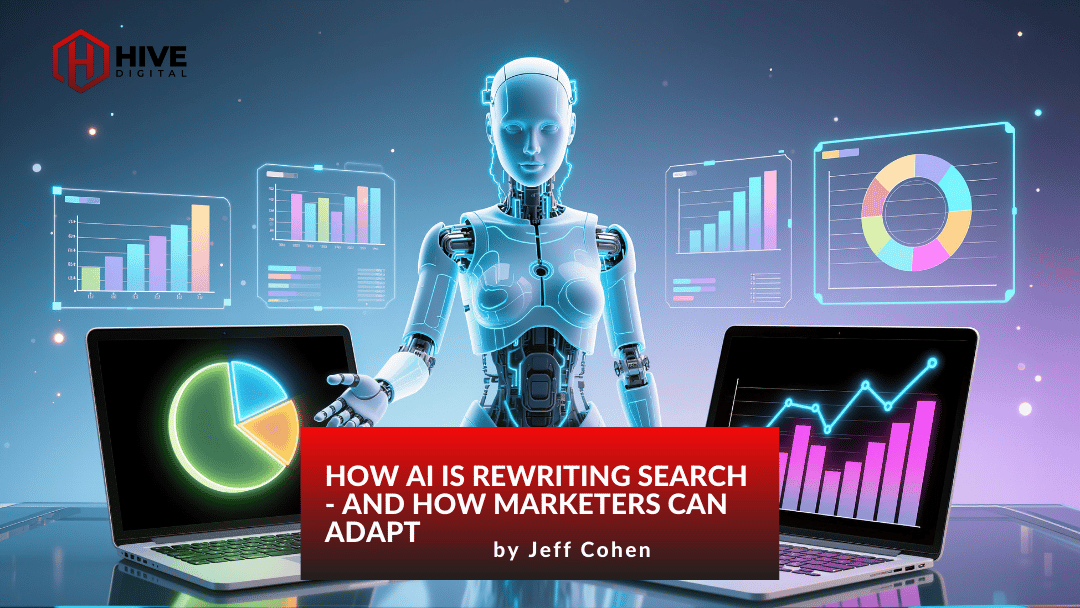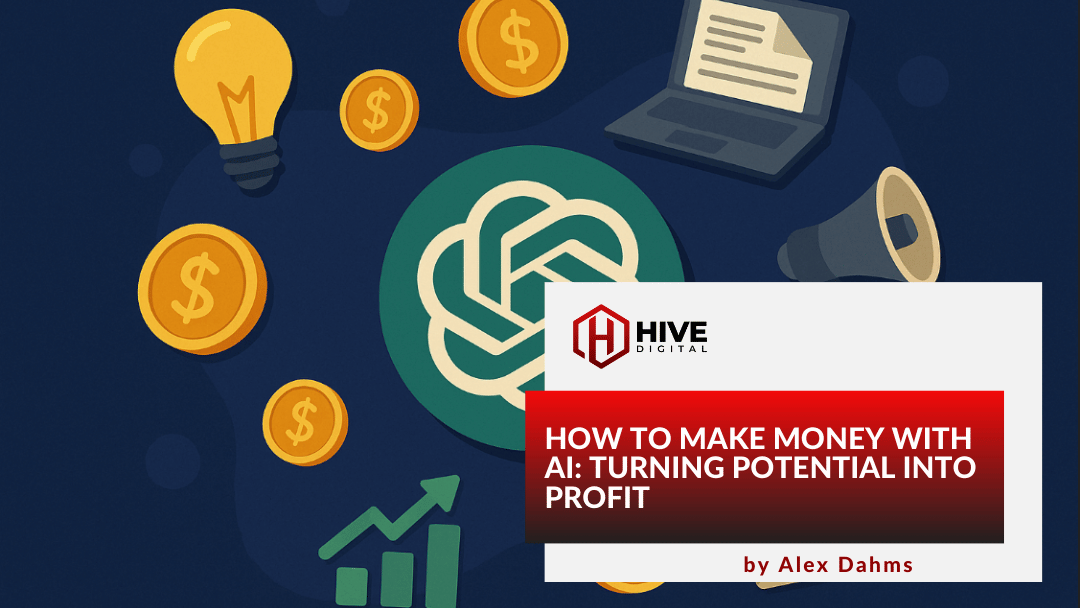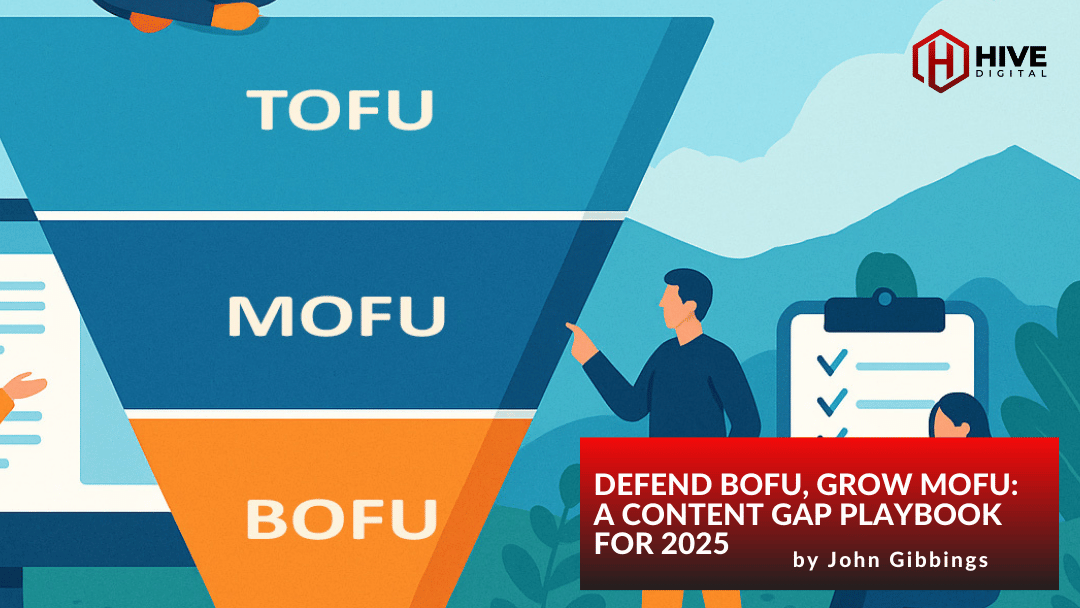Episode Description:
Join the Hive Digital Expert Roundup as we explore the anatomy of a Google result page, sharing the potential paths to optimization and the value of improving how you appear in search.
If you find this information helpful, please also subscribe to our YouTube channel and be sure to set your notifications—we wouldn’t want you to miss out on upcoming tips, trends, and tutorial videos 😉
In this round table episode, you will learn:
- What the different parts of search engine results pages (SERPs) are
- Insight into how Google analyses and ranks content for search engine results
- How Google understand and responds to user intent
- What steps you can take to optimize your content for search engines

Duration: 30 mins
Sheffield Pulley:
All right. I want to thank you all for joining us for what is our second round table. We are excited about the topic today. And I’m excited to have three new consultants with us. In fact, two of our newest, our two newest team members, Jeremy Jarrett, and one of our longest-standing team members. Right, John? You’ve been here for what, 10 years?
John Gibbings:
I think we’re going on about eight to nine years, close to a decade.
Sheffield Pulley:
Nice. Nice, fantastic. We’re excited about the topic today. We’re going to be talking about SERPs, which is also, I think, the most fun word for an acronym in digital marketing, SERP. Be fun stuff. We’re going to be talking about SERP anatomy, probably go down some rabbit holes. These guys have some plans of places they want to take you today. So, I’m looking forward to learning with you as well. Real quickly, let’s do some quick introductions. My name is Sheffield Pulley, director of growth here at Hive Digital. Jarrett, want to introduce yourself quickly?
Jarrett Weathersby:
Yeah. Name is Jarrett Weathersby. I’m on the SEO team, primarily for technical SEO as well as some web analytics. Yeah. I like to get into the nitty gritty, granular fixing up all of the monstrosities and problems that some of our clients have. Even though they think they don’t have it, they definitely have it.
Sheffield Pulley:
Funny how that works. Jeremy?
Jeremy Rivera:
My name’s Jeremy Rivera. I’m a long-time veteran of SEO. I worked for a time with Raven Tools and TapClicks as their in-house SEO. Spun off my own little freelance consulting business. I worked at several different agencies, once did social media for Jeff Foxworthy, but now, I’m home at Hive and making more than redneck jokes, doing some serious SEO.
Sheffield Pulley:
I’m shocked that no one has pivoted from that. And you know you’re old if and played into that. I feel like you could go on for days and days, and days on that. All you, John.
John Gibbings:
Yeah. Hey, my name’s John Gibbings. I work a lot with the content here at Hive Digital building a strategy for growth with a lot of our clients, making sure that we better reach the intent goals behind our main search queries and helping to align with the business goals themselves, making sure we get butts in the seat, make sure that we get some conversions out there, and generally build revenue. Yeah, really excited for today. So, thanks, .
Sheffield Pulley:
Yeah, man. Excited for it as well. I just realized it. We have three Js with us today.
Jeremy Rivera:
.
Sheffield Pulley:
We have an inordinate amount of Js in our organization. I’m not sure why that is. All right. Well, let’s get started. Jeremy, I think you had a direction you’d like to take us to begin. I will let you take it from here.
Jeremy Rivera:
For sure. Search engine results page. When I start conversations with my customers on the first day, when I meet them, I like to break down my approach to Google, is thinking about search engines as a three-part system. You have the crawling and indexing, Google bot doing its job discovering pages. You have the index system where it’s absorbing all of that information and categorizing, and choosing what sites go where in what buckets, and getting all of results ready for the big show: the search engine results page. This is where the rubber meets the road for Google. This is where intent meets results. And when people input their query, either by voice or by typing, or typing a couple letters and following the suggestion given to them, this is the page that’s displayed. And I think with having come from a background of SEO tools, having come from Raven Tools and TapClicks, and having used Ahrefs, and SEMrush, and Majestic, all of those tools divine this experience down to a word and a number.
Jeremy Rivera:
But there’s so much more to ranking nowadays than just a number. You really do have to go into your SERP space, and experience these results, and understand the opportunities that are out there for your business at different levels. So, I have a number of different tabs open with different queries, and we’re just going to start breaking this apart a little bit and introducing the anatomy of a search engine results page. In breaking down, chime in, guys, when I get to different parts if you have questions about different things, your intuition about specific things or experience with it because there’s several ways for this to go. But your most fundamental experience is going to be something like racing drones.
Jeremy Rivera:
So, you input that query, you get this results. First, you have to realize Google makes money, an insane amount of money. And they don’t do that by doing something for free. They get paid. They get paid well for advertising to people when they’re most likely to want to buy something because they’re literally looking for it. So, your opportunity as a provider is always in competition with advertisers. So, if you have money, you can play the game. You can get into these shopping ads results. There are other ad results at the bottom of the page or on the second page. And the intent behind the search itself is going to surface different SERP features. Now, this, for the query, racing drones, the first result is this best racing drones, drone rush result, which is a blog article digging deep, and showing pictures, and information about some of what seems to be the top models of drones.
Jeremy Rivera:
Now, notice when I came back, Google thought, oh, hey, what he saw there didn’t fulfill his intent because now, it has popped up this box of people also searched for, which is different from this box of people also asked. So, Google has done a lot of work in combining data from queries to understand the larger space because we have these longer question type results. How much do racing drones cost? Which drone is best for racing? And you’ll notice that sometimes, it comes through with a thumbnail image, it’s a bulleted list, and guess what? If we go to this particular query, typically, this is all a featured snippet. So, if you have captured the featured snippet for one long tail query, you are also grabbing real estate on the top level related keyword. So, there’s a longer conversation on how do I capture that particular ranking result, but it’s one of those things where if you were unaware that people also ask are powered by those featured snippets, you might miss that opportunity in your content strategy.
Jeremy Rivera:
We also can see that there is a knowledge graph panel. Google has mind information from Wikipedia, pulled thumbnail images about them, and is displaying a rather large amount of information about this in a secondary expanded SERP. You can see here, as we dig into speed and questions about battery time. So, there are multiple paths to expanded information that are opportunities for high competition, in-depth results pages, like racing drones. John, you had mentioned before we came on, something very simple about just choosing the order of the words and how that can change the intent. Do you want to talk about the difference between-
John Gibbings:
It’s really interesting. I was thinking about, okay, you have racing drones, and if you’re going in as a drone website, how do you most likely achieve the target search query? What are you trying to do? I was looking from an intent standpoint, you have drone racing, and then, racing drones. If you look at the two search results, drone racing is more about the entertainment side and less about the individual drone. So, immediately, you’re hit with a bunch of content about drone racing, but not so much about how do you pick up a drone and start to drive it or pilot it, whichever? So, the intent itself is completely different. And I just found that really as a standout query and a fun one to dive into.
John Gibbings:
Here for racing drones, you specifically start getting into the product queries. What type of racing drone do I want? It’s typically someone that knows a little bit about drones because it’s not a DIY drone or a introduction to drones. And it’s more about racing drones. These things are fast. They’re probably fragile, and you want to see someone driving it with some sort of skill. And one thing that’s really interesting too, is up at the top on the right, you start to get some of these secondary queries about the battery life, some of the functionalities behind the products themselves. These are likely individual queries people are looking for. Google has picked up on that. These are the things people are looking for in a fine-tuned machine, and they’re trying to show it right here. So, you’re going to start to do a little bit more research and go into the funnel just from this first page.
Jeremy Rivera:
Definitely. And I think it’s interesting too because once you start, there are these big callout feature blocks. You’ve got your ads, you’ve got your knowledge block. People also ask, apparently, since you can buy it locally, they have them at local stores. You’ve got your three pack of maps showing three results geographically. I remember the good ole days when there was a 10-pack, and then, a-five pack of potential local results. But I haven’t seen a 10-pack in a long time. I think we’re stuck with the three. But that shows local in intent. Google knows that a drone is something you can buy locally. You’ve got a video section with these blue boxes, these callouts from this moment. When you upload anything to YouTube, it can grab these and mark up these key moments.
Jeremy Rivera:
It is interesting to note that if you host your own video, you can grab these key moments with a schema markup. But the majority of the marketplace right now is dominated by YouTube and showing these key moments from videos because people haven’t yet adopted that schema approach. But that’s what I wanted to point out is that there are ups and downs to embedding YouTube videos into your page. On the UAV Coach, if we go to this page, he has a YouTube video embedded on his page here for Walkera. And if we go back to this results page, we can see that it’s actually…
John Gibbings:
And there’s no way . The author of that page, I don’t think was looking for that.
Jeremy Rivera:
Yeah, they didn’t want to advertise, uploaded by Walkera live. So, if you are unaware that when you embed a YouTube video into your page, you’re giving visibility on your results page. Now, interestingly, I don’t have a good way to show it, but if you did the query on your mobile result, you wouldn’t see that text of uploaded by Walkera live. You would see something much more like this with a thumbnail showing the video. So, it’s a little bit of a trade-off and an opportunity for you to consider whether you’re going to host your own video and embed it in your page, or you’re going embed something from YouTube.
Jeremy Rivera:
And as we look at the results page, we can start breaking down to some of the basics of these ordinary results and start thinking about how does that impact our strategy? So, we’ve got the URL for the root displayed here and these breadcrumbs based off of the URL structure of the page. And that’s something that’s changed in the past few years. A few years back, in order to get the breadcrumb breakdown, you had to add additional markup, either schema markup, rich content markup in addition to using that breadcrumb structure. Now, your folder structure for your page displays in that available space, and then, it truncates.
Jeremy Rivera:
So, it is an opportunity for you to surface, in your folder structure, additional information to help drive relevance, to help drive that this is the right result that they want to click on, like racing drones, FPV racing drones. In that structure, you’ve got FPV quadcopter drone systems. So, thinking about URL structure impacts your snippet on a page. You have your title. And I think we all know we, hopefully, are aware that Google has been more aggressive in rewriting titles recently. I think, John, you have an example for one of your clients on how titles are getting rewritten.
John Gibbings:
I did. I had a client with a branded anacronym and a couple other phrases. I’m not going to go ahead and throw that out right now. But they started truncating it down to just the anacronym itself, and they were trying to lowercase the and try and draw the attention more to what the search query is within the page title, as opposed to the long tail branding, which was really interesting to me, where they’re trying to refocus a user’s attention on what the page is about, as opposed to who is creating it.
Jeremy Rivera:
And I think there’s a bit of a thumbprint on, sometimes, you’ll see this semicolon. The title for this page does not have this semicolon in the brand at the beginning of this result, right?
John Gibbings:
That’s right. They didn’t change any of that, actually, for this client. It was really interesting.
Jeremy Rivera:
Right. The title is actually Denver’s Employment Lawyers, and then, pipe Baird Quinn LLC. So, we actually see a rewriting of that pipe, and then, brand here in this query, and sticks out to me that if you are looking in your results and you see your brand is shuffled to the front with that colon, then that Google’s rewritten that particular result. So, another example I came across was data analytics platform. We’ve got Looker, and this is the current title. But if you were Looker-ing for a Looker, they totally rewrote the description, the title, and it’s just the brand name, literally nothing else.
Jeremy Rivera:
So, that’s an interesting case where their choice of title, to exclude their brand name from it resulted in when it did get rewritten, it was replaced in its entirety to just its brand entity as Google goal determined it. So, I thought that’s an interesting factor to add. And it ties into the other top portion, which is meta description, which has always been, or hasn’t ways been, but has, in the past four to six years, I think, open to being rewritten. And we can see a number of these results pages. Google’s just grabbing random content from the description. What’s your take, Jarrett, on the meta description advice? I always suggest to people thinking of, well, it may not always display, but when you can, you want it to exist there as a good supporting call to action. What’s your approach?
Jarrett Weathersby:
Yeah. So, normally, I know even with products, you definitely want to emphasize what the product actually is and what value it brings to the potential traffic. Because usually, if people would normally just choose a search result based off of the title tag. And if they need some further convincing, then you definitely want to have your Ps and Qs on the meta description. So, trying to jam in your 160 characters to feel like, oh, yeah, it does X, Y, and Z, or it can provide this, that, and other value to your particular problem. But sometimes, some people, they don’t put those meta descriptions down, and Google does a halfway decent job of pulling it from your site, especially if you have some good information on some products, or on your homepage, or on your services page. It can pull it down, but definitely, you want to tailor it so that you can put in those keywords.
Jarrett Weathersby:
I know Amazon, Amazon has done it so well, as far as putting the right keywords in, that Google just rips it straight from that rather than trying to customize it. I think that definitely works for e-commerce. If you have a product that’s selling really high, I’m pretty sure, yeah, like the Amazon right there, if it’s selling really high, and like you all mentioned before, somebody who is very much into racing drones, and they see all the characteristics and all the technical specifications of it, they see that in the meta description, they’re going to click on it. They’re going to buy it relatively immediately. But if you’re talking about somebody trying to select hair or trying to find this next hair salon, you definitely want to be a little bit more advantageous with your word, very persuasive, showing how much better you would look compared to if you didn’t have the things, along those lines, such as like the second one.
Jarrett Weathersby:
If you’re looking for a drone, look no further than this place. And then, trying to introduce your brand to the traffic there versus saying, “Oh, yeah, we have the best option available. Here’s the technical specifications. Buy it right now.” That’s normally what the meta description I’ve seen for… But I know one rule of thumb I would like to do is definitely add your brand into it because if you have FPV racing drones, and you do one hour worth of research, and you keep seeing FPV race drone, then you are probably more likely to click on that because you’re seeing it everywhere, versus you just saying, “This is a racing drone.”
Jeremy Rivera:
Cool. So, just in this result, there’s a couple of more interesting features. We’ve got site links here, which go to sub pages. John, what’s your experience with capturing or doing anything specifically to try to trigger these? Because it seems like, oh, this is five links instead of one. So, if I can, I would rather have one result with five links. So, you have any experience in what can lead to some of these additional pages being chose in as your site links?
John Gibbings:
I think it’s worth prefacing with the domain diversity update, which was a Google update that rolled out, what, was it two years ago? To where a single domain can only have two URLs ranking as an organic position in any SERP location. So, here we have Amazon. Typically, a domain would only have two links. But you’ve called out to where we have additional opportunities for users to click into the site. We have, at the very top, we have some of the featured snippets where if you have a list, you can have a read more, like that one, which one was best. And you have these opportunities in addition to the site links to ask people or to call them into your site.
John Gibbings:
Now, to answer your question, internal links is one of the best ways to drive these additional site links that are listed here, either in the navigation. On your site, if you’re directing people through these pages and using anchor text, Google will pick that up. If they start to associate these landing pages and the main features that you offer the products, then you stand a high chance of having those included next to your site. Very valuable tool, and internal linking is definitely something that tends to be overlooked with websites in favor of back links and other external sources of authority.
Jeremy Rivera:
Yeah. It looks like ready-to-fly drones, they have this extra navigation by category. And that seems to be where Google is pulling some of those top four off of. So, that’s a good callout for utilizing anchor text internally. This result is interesting to me because it has a meta description, but then, boom, what’s this extra stuff? Where’s this coming from? It’s coming from tabular data. It used to be 2006 to 2003, 4, 5, 6, 7 to 2012, most websites were actually a mess of just nested tables. This was before CSS was really a thing or utilized. And if you wanted to layout a page, you had tables everywhere. And Google came out and said, “No, no, no, that’s not what you use tables for. You use tables for data.”
Jeremy Rivera:
And we use tabular data. John , just last week pointed out, yeah, tables are effective in helping Google connect two data points together. And so, we can see that there are benefits for including tabular data. You get this nice extra box. So, for predicting SEO traffic, I put a table in I1, this tabular data callout. And I also want to call out with it that, hey, emojis are a thing. You can get emojis in your tabular data. You can have emojis in your meta description. Heck, you can even have emojis in your URL.
Jeremy Rivera:
John Henshaw of Coywolf, he actually has an emoji domain that’s a light bulb and a wolf emoji. So, don’t forget that if you’re not in a crazy serious SERP, you might be able to pull off dropping an emoji into a title field, a description field, or a table that might get captured, and give you a little bit of extra visibility, give you a little bit of a callout effect, like you can see here. You don’t usually see a Ferris wheel in results, so it can be an extra callout and capture of attention.
John Gibbings:
That’s also your birthday. I’m sorry, December 17th. I was excited to call that out.
Jeremy Rivera:
Oh. Yeah. Date feature. So, if you’re publishing blogs, the date stamp that’s communicated in your schema shows up. There are results that also list an author name or a site cited by. There are other feature callouts, like in stock. Some queries will have price. Those can be won by applying appropriate schema tags. And so, it’s not just a meta description and meta title field impacting, it’s your content choice, it’s your URL structure, it’s your callouts, including tabular data. Are there any other pieces or items on your page that you guys can think of, off the top of your head, that can change your SERP results for a particular page?
John Gibbings:
One thing, it’s an adjacent answer, is going back to the query intent. One of our clients works with first aid, and specifically, how to stop the bleed. And what you can do is are you trying to avoid going to the ER? Do you need to stop it right now? Or are you trying to learn? So, there’s a little bit of a variation behind what actually you’re looking for with the query. And sometimes, Google doesn’t always get it right. So, sometimes, there’s some shifting.
John Gibbings:
Here, we have a lot of educational based stuff, but maybe how to apply a Band-Aid. Or I need to put a Band-Aid on my finger because it’s about to be cut off. So, there’s a lot that you can take from the search results. And it just takes a little bit of diving in that sometimes, they don’t always get it right. That there’s a lot of information you can do to present the page, but at the end of the day, as you’re trying to get people into your site, and ultimately, convert, it is worth considering what the main message is behind that. So, what are you trying to achieve? Are you trying to sell Band-Aids? Are you trying to get people into your local urgent care? So, there’s a bit of leg work on what you’re trying to do to communicate that. And just something to consider.
Jeremy Rivera:
There is definitely one more, which is FAQ schema. You can see a result here on G2. They’ve included, what is PCB design software? NYU’s PCB design software. And they communicated this information and have grabbed these expandable results that look a lot like these people also ask, but are specific to this domain and provided for them. So, that’s another opportunity for you to add additional relevant questions and mark them up appropriately, and actually expand, see that they’re down here at the bottom, and they’re marked up with FAQ schema. And they’ve grabbed not only the first ranking spot, but an expanded first ranking spot with these additional callouts of extra text. So, I think thinking about the intent of somebody looking for products and somebody thinking about SERP results, I want to encourage everyone to treat Google as the ultimate SEO tool.
Jeremy Rivera:
If you go here and you input your target query, what shows up here in the forms, it takes our telling you what are the different ways that Google understands that intent, and so, you can play along, and you can find ways to write about speed and battery time or other features. You can try to create relevant additional videos, update your internal links to try to get those callouts. You can add tabular data, FAQs, and mark them up appropriately and gain more results. But it really is going beyond just looking at that ranking number and having experience there. And Jarrett, you had a point that you wanted to get across about results pages as well.
Jarrett Weathersby:
For sure. Yeah. Definitely try trying to be solely focused on trying to get the number one position is probably not the best result or a best approach. I would definitely say provide value to the traffic that you’re trying to track with your keywords and your search results. Because even if you have the number one result does not mean you are going to convert the most out of everybody on the first page. So, definitely providing value, definitely providing information, definitely providing what you want to give to your customer, such as maybe a free download to a PDF based off of some series of questions that need to be answered. That can provide a lot of value for free that could eventually lead to converting to a actual product or service being purchased. But I know Sheff wanted to wrap some stuff up.
Sheffield Pulley:
Yep. That was a perfect place to dot, dot, dot the conversation until our next round table. This has been fantastic. Anything you guys want to add? Any bow you want to wrap around this discussion before we call in an afternoon?
Jeremy Rivera:
Yeah. Just reiterating. Go beyond the ranking report, and go and explore these results pages. I promise you will come away inspired and intimidated by how much work you have in front of you, but also, how much opportunity is out there. There’s all kinds of ways for you to show up in those results pages with an open mind.
Sheffield Pulley:
Great. Jarrett, John, anything? Wrap things up?
Jarrett Weathersby:
I would definitely want to try to be consistent. I know when creating content, you get the hum drum of let’s just throw it up there rather than taking your time, putting your technical on-page things together, making sure you’re using the right keywords. If you make a habit out of it, you won’t have to rely solely on trying to find every nook and cranny. Obviously, you want to exploit it as much as possible. But if you’re consistent with it, it’ll definitely help out in the long run, for sure.
Sheffield Pulley:
John, anything? Great. Awesome. All right, fellas, this has been fun. Thank you so much. Really appreciate all your efforts. Looking forward to the next time. We will be back with you in a month or so, hopefully, a little sooner, with a few of our other consultants. We’re going to dive into… Not sure exactly what we’re going to dive into yet. It’ll be fun to see. So, thank you all for joining us. Hope you have learned a little something or two, and I will see you next time. Thank you.
John Gibbings:
Bye.
Jarrett Weathersby:
Bye. (silence).
Meet Your Hosts:

John Gibbings

Jarrett Weathersby

Jeremy Rivera









